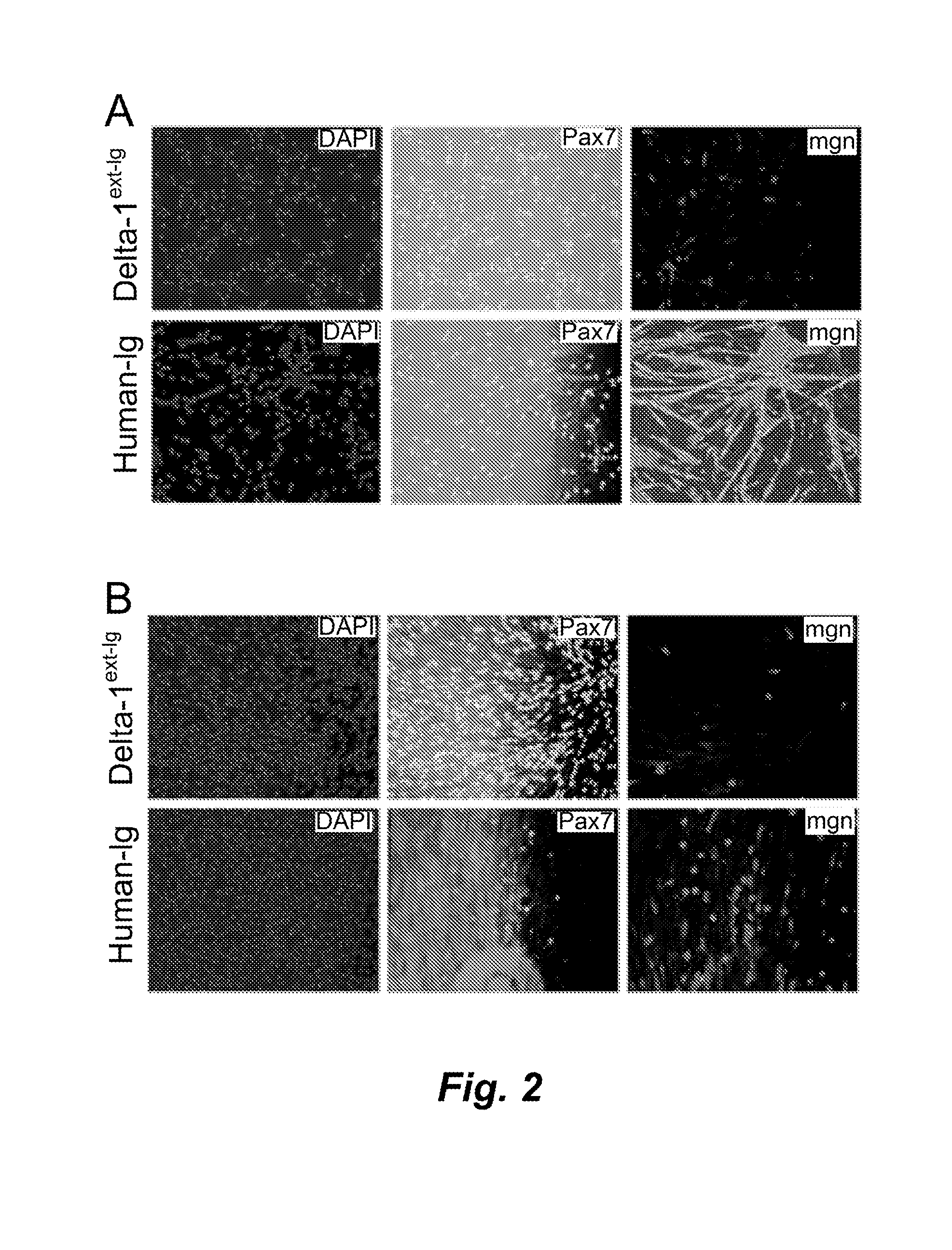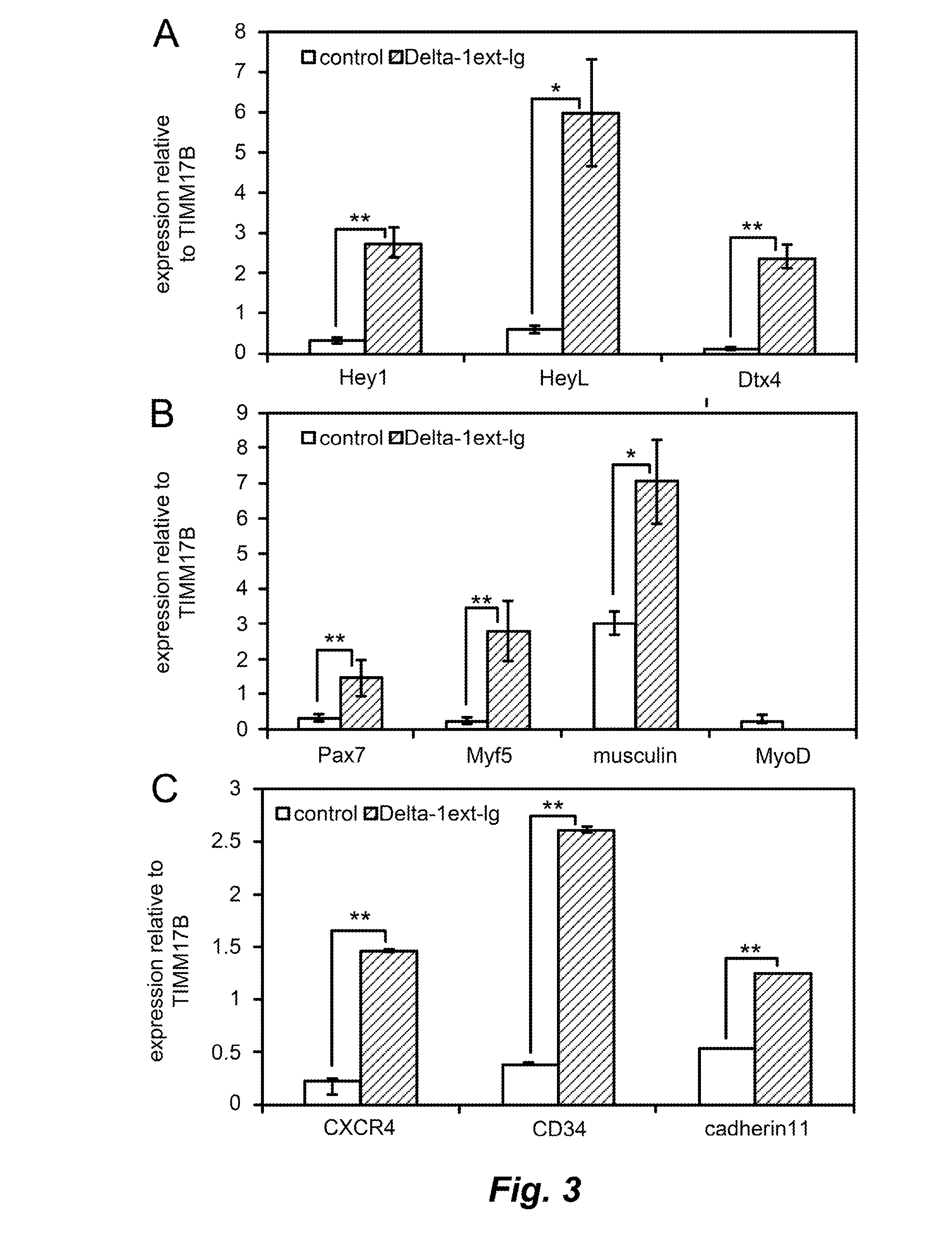Ex vivo expansion of myogenic stem cells by notch activation
a myogenic stem cell and ex vivo technology, applied in the field of tissue repair by stem cell transplantation, can solve the problems of affecting the engraftment of donor satellite cells, affecting the engraftment of muscle tissue, and unable to provide enough cells, so as to promote muscle regeneration, promote muscle tissue regeneration, and increase the engraftment potential to a transplantation site.
- Summary
- Abstract
- Description
- Claims
- Application Information
AI Technical Summary
Benefits of technology
Problems solved by technology
Method used
Image
Examples
example 1
Ex Vivo Expansion of Myogenic Precursors that are Capable of Muscle Engraftment
[0049]Materials and Methods:
[0050]Donor Cell Isolation.
[0051]The Institutional Animal Care and Use Committee at the Fred Hutchinson Cancer Research Center, which is fully accredited by the Association for Assessment and Accreditation of Laboratory Animal Care, approved this study. Elevated enclosed runs were used for housing, and dogs were maintained in social groups wherever possible. All dogs were enrolled in a veterinary preventative medicine program that included a standard immunization series against canine distemper, parvovirus, adenovirus type 2, parainfluenza virus, coronavirus, and rabies.
[0052]Each donor canine underwent a maximum of 4 skeletal muscle biopsies. For each canine-to-murine transplantation experiment, a 1 cm×1 cm×0.5 cm skeletal muscle biopsy was harvested from the biceps femoris muscle of the donor canine. The muscle biopsy was trimmed and cut into smaller pieces along the length o...
example 2
Upregulation of Wnt Signaling Pathway Components by Notch Activation
[0127]A survey by RT-qPCR of Wnt receptor expression in proliferating myoblasts and in myogenic precursor cells expanded on either Delta-1ext-IgG or human IgG (as described in Example 1) demonstrated that Fzd2, Fzd4, Fzd7, Ror2, and Ryk were expressed in canine muscle derived cells (FIG. 7A). Activation of Notch signaling in the same cells increased expression of Fzd4, a mediator of non-canonical Wnt signaling, and Dkk2, an extracellular antagonist of canonical Wnt signaling (FIG. 7B). Wnt3a has been shown to stimulate proliferation of Pax7+ cells in vitro, yet Brack and colleagues demonstrated that treating muscle after injury with Wnt3a activated canonical Wnt signaling, and stimulated differentiation at the expense of myogenic progenitor proliferation (Brack et al., 2007 Science 317:807; Brack et al., 2008 Cell Stem Cell 2:50; see also Otto et al., 2008 J. Cell Sci. 121:2939). On the other hand, Wnt7a, acting thr...
PUM
| Property | Measurement | Unit |
|---|---|---|
| density | aaaaa | aaaaa |
| temperature | aaaaa | aaaaa |
| temperature | aaaaa | aaaaa |
Abstract
Description
Claims
Application Information
 Login to View More
Login to View More - R&D
- Intellectual Property
- Life Sciences
- Materials
- Tech Scout
- Unparalleled Data Quality
- Higher Quality Content
- 60% Fewer Hallucinations
Browse by: Latest US Patents, China's latest patents, Technical Efficacy Thesaurus, Application Domain, Technology Topic, Popular Technical Reports.
© 2025 PatSnap. All rights reserved.Legal|Privacy policy|Modern Slavery Act Transparency Statement|Sitemap|About US| Contact US: help@patsnap.com



